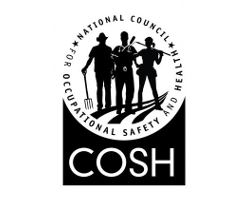Prosecution, Penalties and Prevention Needed to Address Annual Toll of 54,000 Workplace Deaths

Longmeadow, MA, April 24, 2015 - The National Council for Occupational Safety and Health, responding to the annual toll of more than 50,000 on-the-job deaths in the United States, said today that an aggressive program of prevention strategies in the workplace can reduce exposure to hazards and save lives in U.S. workplaces.
“54,000 deaths a year is way too many,” said National COSH Executive Director Mary Vogel. “We need tougher penalties. We need prosecutions for criminal violations. And we need to listen to workers, and use proven strategies that protect all workers, reduce injuries and save lives.”
Marking the beginning of Workers Memorial Week, which will be observed around the country and around the globe from April 25th through May 2nd, National COSH released “Not an Accident: Preventable Deaths 2015.”
Key information from this year’s report:
4,585 U.S. workers died on the job due to unsafe working conditions in 2013 the most recent data available from the U.S. Bureau of Labor Statistics.
An estimated 50,000 workers die each year from long-term exposure to hazardous substances such as asbestos, silica and benzene.
Hispanic workers continue to be at greater risk than other groups, showing a nine percent increase in sudden workplace fatalities between 2012 and 2013. During the same period, the incidence of fatalities decreased for African-American, Asian and white workers.
Proven prevention strategies are available for all the major categories which result in worker deaths, including transportation incidents, contacts with objects and equipment, falls to a lower level, workplace violence, exposure to harmful substances and environments and fires and explosions.
Making Work Safer: Local COSH groups around the country are responding to fatalities and injuries on the job through advocacy, research, training and organizing; we highlight actions taken by organizations across the country during the past year.
The report also presents case studies of seven workers who died on the job in 2014, from different industries and different parts of the country, with each case illustrating how workplace hazards can be reduced and lives saved if proper safety protocols are followed.
During a media briefing to announce the release of today’s report, Celeste Monforton, DrPH, a public health consultant and professorial lecturer at George Washington University, discussed the upcoming trial of former Massey Energy CEO Don Blankenship. He has been indicted for conspiracy to violate mine safety laws, following the death of 29 miners at the Massey-owned Upper Big Branch mine in 2010.
“This trial will be a wake-up call for corporate America,” said Monforton. “If you cut corners, if you operate unsafely and people get hurt as a result, you can be held accountable in a court of law. I’m not sure many companies understood that before; I hope they understand it now.”
Three former Massey executives are currently serving prison terms after pleading guilty or being convicted on charges stemming from the Upper Big Branch disaster.
Mary Jane Collins of Sheridan Wyoming, who lost her 20-year old grandson Brett on a construction site 2012, talked about her efforts to increase penalties for safety violations in the state of Wyoming. Brett Collins died when struck by an excavator while working in a trench. After penalties for Brett’s death were reduced to less than $3,000, family members were outraged.
“My grandson died just a few days before he was going back to school,” said Collins. “We don’t want anyone else to suffer a loss like we have. Our thinking is, if employers have to pay a real fine when something goes wrong, they’ll make sure to the job right in the first place.”
Wyoming legislators, working with the Collins family, have introduced a bill that would require a $50,000 fine for safety violations that lead to the death of a worker.
“In 2015, there’s no reason for a worker to die in a trench or due to a fall from a building or any other workplace hazard,” said Peter Dooley, a project consultant for National COSH. He has investigated dozens of workplace fatalities during a decades-long career as a workplace safety specialist. “I’ve seen every hazard you can think of in every kind of workplace. I haven’t seen one yet that can’t be controlled or eliminated – if you establish health and safety programs with proven components such as worker participation.”
Workers Memorial Week will be observed this year in 80 local communities in 29 states with vigils, rallies, marches and other events to honor fallen workers and advocate for better safety protections. A listing of events is available on the National COSH website.
On April 28th, National COSH will release the U.S. Worker Fatality Database, the most comprehensive effort to date to gather specific information about workplace deaths. It will cover some 1,500 fatalities, about one-third of all workers who died on the job in 2014, with an interactive map feature to show where the incidents took place. The new database, linked from the National COSH website, will be available to the public, policy makers and news media.

